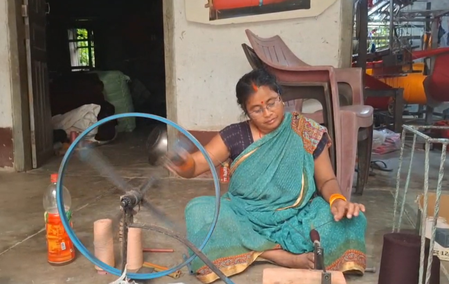

Bagaha (Bihar), July 31 (IANS) In the heart of Bagaha, government schemes like the Mudra Yojana are not only revitalising traditional crafts but also empowering women with sustainable livelihoods. Two local cooperatives — the Gramin Mahila Vikas Bunkar Swavlambi Sahkari Samiti and the Dhirauli Prathmik Oon (Wool) Bunkar Sahayog Samiti — stand as testaments to the transformative impact of financial inclusion and grassroots entrepreneurship.
Gramin Mahila Vikas Bunkar Swavlambi Sahkari Samiti: A loom of empowerment
This cooperative, run entirely by women, operates a handloom centre where a variety of woolen and cotton products such as shawls, sweaters, stoles, saris, towels, gamchas, and mufflers are produced. Currently, 25 women are directly employed through this initiative, gaining both financial independence and social confidence.
Rukmani Devi, one of the beneficiaries, shared her experience: “I received Rs 5 lakh under the Mudra Yojana from the government. This financial support helped me expand our operations and provide more employment opportunities to local women. We are not just earning; we are contributing to women’s empowerment in our village.”
She further expressed her aspirations, stating: “We now need more funding so we can purchase modern machines that are essential for scaling up our production and improving efficiency.”
Dhirauli Prathmik Oon (Wool) Bunkar Sahayog Samiti: A legacy since 1969
Established in 1969, the Dhirouli Cooperative has been a cornerstone of the weaving tradition in the region. Here, 40 artisans, including many women, are engaged in producing shawls, bedsheets, gamchas, and traditional woolen wraps.
Harindra Kaji, a senior member of the cooperative, noted: “We’ve been supported by the government with a new building and advanced weaving machines. These resources have significantly boosted our productivity and working conditions.”
Devanti Devi, who has worked here for years, said: “About 40 to 50 women work together to produce high-quality handmade items. This has become our main source of livelihood.”
As Narmada Devi carefully crafted a shawl, she added: “We make shawls and sweaters. This work supports our families and keeps our traditional skills alive.”
Transformation of Harna Tanr: From insurgency to development
Once considered a hub of Maoist activities, Harna Tanr, the anchor region of Tirhut, has undergone a remarkable transformation. Today, it is seen as a rising centre of education, health, and employment. Government initiatives like the Mudra Yojana have played a critical role in this turnaround, offering financial support and infrastructure to uplift local communities. What was once a conflict-affected zone is now a model of development where policies meet potential — and weaving looms power dreams.
–IANS
brt/pgh
